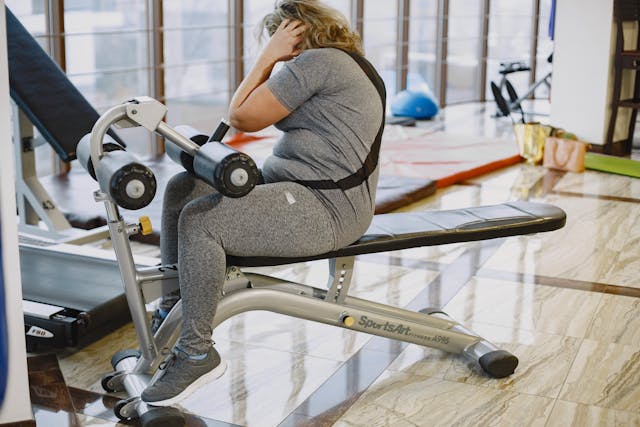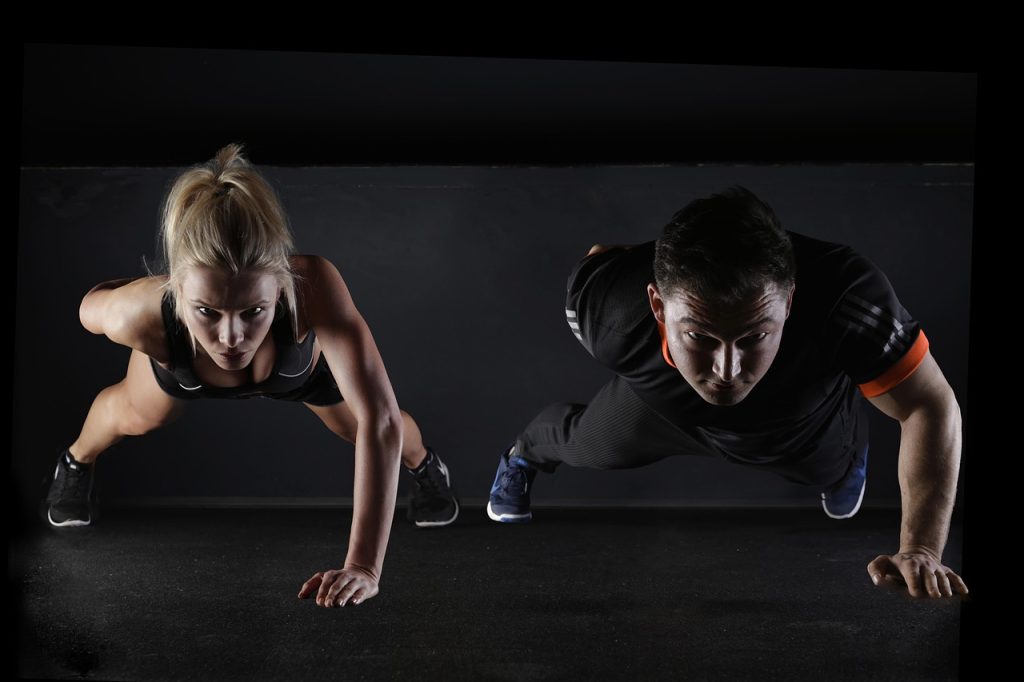15 High-Intensity Interval Training (HIIT) Secrets for Rapid Fat Loss 🔥

When it comes to burning fat fast, nothing beats High-Intensity Interval Training (HIIT) 🚀. This workout style is scientifically proven to torch calories, increase your metabolism, and build lean muscle in less time than traditional cardio. If you’ve been struggling to shed stubborn fat, HIIT could be the missing piece in your fitness journey.
Why High-Intensity Interval Training Is a Game-Changer 🏋️♂️
Unlike steady-state cardio, HIIT alternates between short bursts of intense effort and periods of low-intensity recovery. This not only challenges your body to work harder but also keeps your metabolism elevated for hours after your workout — a phenomenon known as the “afterburn effect.” That means you continue burning calories even while resting!
How High-Intensity Interval Training (HIIT) Helps You Burn Fat Faster Than Ever ⚡
High-Intensity Interval Training (HIIT) isn’t just about sweating; it’s about training smarter. By combining anaerobic bursts with aerobic recovery, HIIT engages multiple muscle groups, improves cardiovascular health, and encourages your body to use fat as a primary energy source. In just 20 minutes, you can burn as many calories as you would in an hour of jogging — all without the boredom!
Read more: 10 Powerful Bodyweight Exercises for Beginners at Home (No Equipment)
The 15 HIIT Secrets You Need to Know for Rapid Fat Loss 🥇
Ready to unlock the full power of High-Intensity Interval Training (HIIT) for faster fat loss? 🔥 These 15 proven tips will help you train smarter, burn more calories, and transform your fitness in less time. 💪 Let’s dive in!
-
Start with a Solid Warm-Up 🔥
Jumping into HIIT without warming up is like racing a car without starting the engine — dangerous and ineffective. Spend at least 5–10 minutes preparing your body with dynamic stretches, light jogging, or jumping jacks. Warming up increases blood flow to your muscles, improves joint mobility, and reduces the risk of injury. Plus, it mentally primes you for the intensity ahead.
-
Focus on Short, Intense Bursts ⏱️
The key to HIIT is pushing your body close to its maximum effort during the high-intensity phases. Aim for 20–40 seconds of all-out work, followed by 10–30 seconds of rest. This intensity triggers a metabolic response that continues to burn fat even after the workout. Remember, quality over quantity — go hard, then recover.
-
Incorporate Compound Movements 💪
Exercises like burpees, jump squats, and push-up to plank rows engage multiple muscle groups at once, making your workout more efficient. Compound movements burn more calories, build strength, and improve functional fitness. They also increase the challenge, keeping your heart rate high throughout the session.
-
Mix Cardio and Strength Training 🏃♀️🏋️♂️
Instead of sticking to only bodyweight cardio exercises, add resistance training to your HIIT routine. Kettlebell swings, dumbbell thrusters, and weighted lunges can significantly enhance fat loss while preserving lean muscle mass. This combination not only improves your physique but also boosts metabolic rate.
-
Track Your Intensity with a Heart Rate Monitor ❤️
HIIT works best when you push your heart rate to about 80–95% of your maximum during intense intervals. Using a fitness tracker or heart rate monitor helps ensure you’re hitting the right intensity for optimal fat burning. It also prevents overtraining and keeps you in the safe zone.
-
Keep Workouts Short but Effective ⏳
One of the biggest mistakes people make is turning HIIT into a marathon session. The beauty of HIIT is its efficiency — 15–30 minutes is enough. Longer sessions can lead to fatigue and reduced performance. Focus on giving your best effort in a short timeframe to maximize results.
-
Change Your Routine Regularly 🔄
Doing the same HIIT workout every day can lead to plateaus and boredom. Rotate exercises, intervals, and intensity levels every 2–3 weeks to keep your body challenged. For example, switch from sprint intervals to cycling, or add plyometric movements for a fresh burn.
-
Fuel Your Body Properly 🥗
Nutrition plays a huge role in HIIT success. Fuel up with complex carbs like oats or sweet potatoes before your workout, and replenish with protein-rich foods afterward to support muscle repair. Avoid heavy meals right before HIIT, as they can slow you down and cause discomfort.
-
Prioritize Recovery Days 😴
HIIT is intense, and your muscles need time to recover. Aim for at least 48 hours between HIIT sessions targeting the same muscle groups. On rest days, opt for light activities like walking, stretching, or yoga to aid recovery while keeping your body active.
-
Stay Hydrated 💧
High-intensity workouts cause significant fluid loss through sweat. Dehydration can impair performance, slow recovery, and even increase the risk of injury. Drink water before, during, and after your workout. Electrolyte drinks can also be beneficial if your sessions are longer than 30 minutes.
-
Use Tabata for Maximum Efficiency ⚡
Tabata is a HIIT method involving 20 seconds of all-out effort followed by 10 seconds of rest, repeated for 4 minutes. This format is incredibly time-efficient and can be applied to exercises like sprints, squats, or push-ups. Despite its short duration, Tabata burns serious calories.
-
Listen to Your Body 🧠
Pushing yourself is great, but ignoring pain or extreme fatigue can lead to injuries. Learn to differentiate between muscle burn from effort and sharp pain from strain. Adjust your workout accordingly, and don’t hesitate to take an extra rest day if needed.
-
Add Resistance Bands for Extra Challenge 🏋️
Resistance bands are portable, affordable, and perfect for making bodyweight exercises more challenging. They increase muscle engagement and help improve strength without heavy weights. Try banded squats, push-ups, or glute bridges for an added burn.
-
Track Your Progress 📊
Keeping a workout log helps you see improvements over time and stay motivated. Record your exercises, intervals, heart rate, and how you felt during each session. Progress tracking also helps you fine-tune your routine for maximum fat loss results.
-
Combine HIIT with Active Lifestyle Habits 🚴
HIIT is powerful, but combining it with daily activity — like walking more, taking the stairs, or cycling to work — can accelerate fat loss even further. The more you move throughout the day, the more calories you burn, making your HIIT sessions even more effective.
Read more: 10 Powerful Benefits of a 5-Minute Daily Stretching Routine to Boost Flexibility Fast
Advanced Strategies to Maximize Your HIIT Results 🚀
Once you’ve mastered the basics of High-Intensity Interval Training (HIIT), it’s time to level up your approach. Advanced strategies can help you burn fat more efficiently, prevent plateaus, and improve overall performance. The key is to keep your body guessing while maintaining the right balance between intensity and recovery.
Integrate Periodization for Sustainable Progress 📅
Periodization involves varying your High-Intensity Interval Training (HIIT) workouts over weeks or months to prevent adaptation. Instead of doing the same exercises every session, you can rotate between high-volume, high-intensity, and recovery-focused weeks. This method not only reduces the risk of overtraining but also keeps your metabolism and fat-burning potential high over the long term.
Incorporate Sprint Intervals for Explosive Power 🏃♂️
Adding sprint intervals to your HIIT routine can drastically improve cardiovascular endurance and muscle strength. Whether you run on a treadmill, cycle, or use a rowing machine, all-out sprints push your heart rate into peak zones, triggering a stronger afterburn effect. Start with short sprints of 15–20 seconds, then gradually increase the duration as your fitness improves.
Combine HIIT with Resistance Circuits 🏋️♀️
Pairing High-Intensity Interval Training with resistance exercises amplifies fat loss while maintaining muscle mass. For example, you could perform kettlebell swings, followed by jump squats, then move on to push-ups with minimal rest. This not only boosts calorie burn but also enhances muscular endurance and strength.
Use Progressive Overload in HIIT Sessions 📈
To keep seeing results with your High-Intensity Interval Training (HIIT), you must gradually increase the challenge of your workouts. This could mean adding more intervals, increasing work duration, reducing rest time, or using heavier resistance. Progressive overload ensures continuous adaptation, meaning your body won’t get too comfortable with the same routine.
Experiment with EMOM and AMRAP Formats ⏳
EMOM (Every Minute on the Minute) and AMRAP (As Many Rounds As Possible) are creative HIIT formats that push your limits. EMOM involves starting a new set of exercises every minute, while AMRAP challenges you to complete as many rounds as possible in a given time. Both methods are excellent for fat loss and conditioning.
Train in Different Environments 🌳
Changing your workout location can boost motivation and challenge your body in new ways. Try outdoor sprints, beach workouts, or park circuits. Uneven terrain and environmental factors can add a functional fitness element to your High-Intensity Interval Training (HIIT), making it more exciting and effective.
Read more: 12 Proven Tips to Burn Belly Fat Naturally Without Gym
Focus on Proper Breathing Techniques 🌬️
Many people overlook the role of breathing in High-Intensity Interval Training. Controlled breathing helps deliver oxygen to working muscles, reduces fatigue, and improves endurance. Practice inhaling deeply during rest periods and exhaling forcefully during work intervals to maintain performance.
Optimize Recovery Nutrition 🥗
What you eat after HIIT matters. A balanced post-workout meal with protein, healthy fats, and complex carbs helps replenish glycogen stores and repair muscle tissue. Examples include grilled chicken with quinoa, Greek yogurt with berries, or a protein smoothie with spinach and banana.
Track Recovery with HRV (Heart Rate Variability) 📊
Heart Rate Variability is a measure of your body’s readiness to perform during High-Intensity Interval Training (HIIT). Using fitness trackers to monitor HRV can help you decide when to push hard and when to scale back. Low HRV readings may indicate the need for extra recovery, ensuring you avoid burnout and injury.
Apply the 80/20 Rule for Longevity ⚖️
While High-Intensity Interval Training (HIIT) is highly effective, it shouldn’t dominate your entire fitness plan. The 80/20 rule suggests that 80% of your training should be moderate-intensity activities, while 20% should be high-intensity. This balance helps you stay consistent, avoid overtraining, and maintain overall health.
Common Mistakes to Avoid in HIIT Workouts ❌
Even the most dedicated fitness enthusiasts can make mistakes that hinder their HIIT results. Avoiding these pitfalls will help you stay safe and maximize your fat loss potential.
Skipping Warm-Ups and Cool-Downs 🥶
Neglecting a proper warm-up can lead to injury, while skipping cool-downs may cause muscle stiffness. Always include at least 5 minutes of dynamic stretching before and after your High-Intensity Interval Training (HIIT) session to prepare your body and aid recovery.
Doing HIIT Too Often 🗓️
Because of its intensity, HIIT should be done only 2–4 times per week. Overdoing it can lead to fatigue, hormonal imbalances, and even weight gain due to stress hormones.
Focusing Only on Cardio Exercises 🏃♀️
High-Intensity Interval Training (HIIT) can and should include resistance training for optimal results. A mix of cardio and strength ensures a higher calorie burn and improved body composition.
Not Tracking Progress 📒
Without tracking your workouts, it’s hard to measure progress or adjust your plan. Keep a log of exercises, intensity, and performance improvements to stay on track.
Read more: Complete Fitness and Exercise Guide for a Healthy Lifestyle 💪🏃♀️0
FAQs About High-Intensity Interval Training (HIIT) ❓
1. Is HIIT suitable for beginners? 🆕
Yes! Beginners can start with low-impact exercises like cycling, brisk walking, or modified burpees, and gradually increase intensity as their fitness improves.
2. How long should a HIIT session be? ⏱️
Most effective HIIT workouts last 15–30 minutes. The goal is to give maximum effort during work intervals and adequate rest during recovery periods.
3. Can HIIT help with belly fat? 🔥
HIIT is one of the most effective methods for reducing overall body fat, including belly fat. However, spot reduction is not possible — fat loss occurs throughout the body.
4. How many times a week should I do HIIT? 📅
2–4 sessions per week is ideal for most people. This allows enough recovery time while still providing the metabolic boost and fat-burning benefits of HIIT.
5. Do I need equipment for HIIT? 🏋️♂️
No, you can perform HIIT using just your body weight. However, adding equipment like kettlebells, resistance bands, or dumbbells can increase intensity and variety.
6. Is HIIT safe for people with joint issues? 🦵
Low-impact HIIT options like swimming, cycling, or rowing are safer for individuals with joint concerns. Always consult a healthcare provider before starting a new workout routine.
7. Can HIIT improve endurance? 🏆
Yes, HIIT improves both aerobic and anaerobic endurance, making you stronger, faster, and more resilient in other sports or daily activities.
Final Thoughts 💡

High-Intensity Interval Training is one of the fastest, most effective ways to burn fat, build muscle, and improve cardiovascular health. By applying these 15 HIIT secrets consistently, you can transform your body and achieve results in less time. Remember — intensity, recovery, and consistency are the keys to making HIIT work for you.
Want to learn more about High-Intensity Interval Training (HIIT) and how it transforms your body? Check out this comprehensive HIIT guide for expert insights.
For additional workout ideas and training plans, visit this helpful HIIT resource to take your fitness to the next level.


